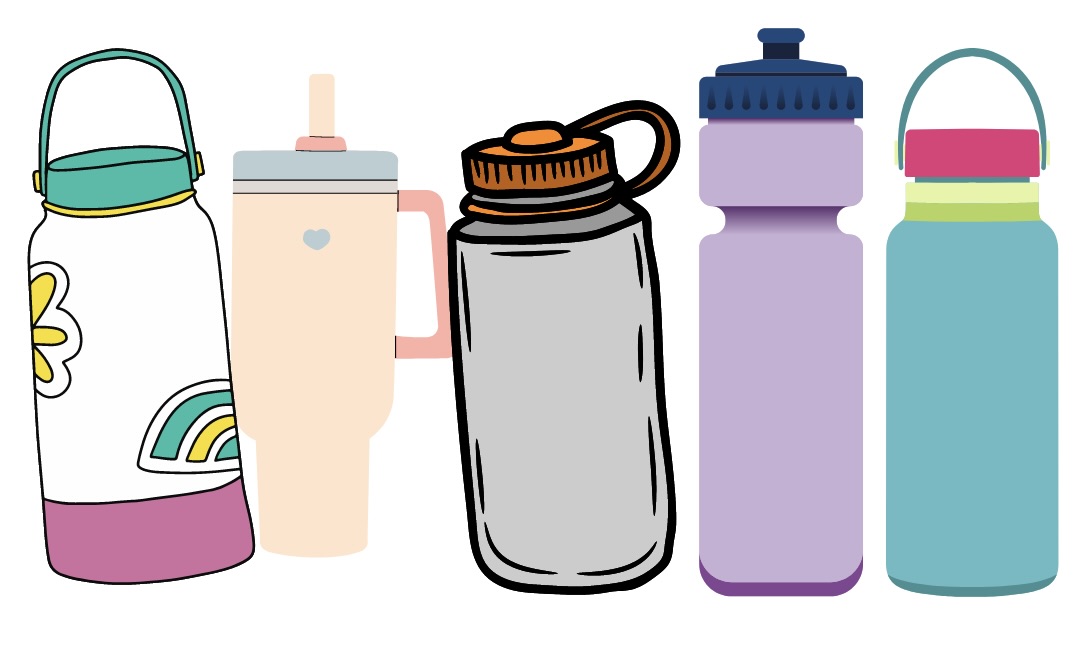As a 20-year-old, I can map out my last five years in water bottle fads. The first year of high school introduced me to the Hydro Flask: a chubby cylinder available in endless colors, each one embossed with a stick-ish man whose head appears to explode into rays. Not long after came the S’well, a bottleneck design with rounded edges, a twist off cap and printed patterns.
Breaking up the monocolor mold, the Owala burst onto the scene several months ago, with fun color combinations and a versatile sip-straw spout. Right now, we’re in the middle of a Stanley storm. A clunky deviant from the cylinder, the Stanley sports a large carry handle with a large volume capacity that’s sure to keep you from needing a frequent refill.
Reusable water bottles are often promoted as sustainable measures, as an ethical alternative to the wastefulness of plastic water bottles (“save the turtles,” anyone?). Companies like Owala and Stanley tout their products as reusable and environmentally friendly, and, to some extent, they are. The Stanley, for example, has a “Built for Life” guarantee and aims to make 50% of its products with recycled steel by 2025. Hydro Flask currently uses 80% recycled materials in its production and offers a trade-in program to continue the lives of flasks in use.
At least according to their corporate ethos, these bottles fit neatly into a circular economy. In contrast to a linear economy where items are used then discarded, a circular economy keeps goods in circulation for longer, using techniques such as efficient and sturdy product design. At the end of their lives, these products are easily recyclable into other new useful products.
Metal flasks are seen as sustainable measures, but their digital footprint of overconsumption throws this violently into question. Stanleys are the latest victim. Numerous videos of shoppers in apocalyptic scrambles for the newest editions have surfaced online. Olivia Rodrigo along with Barbie and Starbucks have all partnered with the company to offer limited editions of the product. Log on TikTok and you’ll see a myriad of Stanleys being dressed up like dolls in attachable snack trays, carrying straps, sauce cups and even phone holders.
Metal flasks are not the first reusables to take the heat. In 2021, the New York Times published “The Cotton Tote Crisis,” a harsh look at the real environmental impact of tote bags. Made of biodegradable fabric, tote bags were marketed as a sustainable alternative to single use plastic bags. Before long, tote bags flooded the market, becoming signature staples of brands and consumer fashion. Trader Joe’s, L.L. Bean and the New Yorker put out viral editions of a simple canvas bag. Individuals in this article from the New York Times noted having from six to 25 tote bags — arguably more bags that one can keep in regular rotation.
The water bottle craze gives one a sense of eerie déjà vu. Consumers — even those safe from Stanley mania — often have too many water bottles than they know what to do with. Water bottles don’t need to be part of a trend to be excessive: they’re often offered at promotional events and are sold as pieces of artist merchandise. It feels impossible to only have one or two bottles that are used regularly. When the aesthetic value of these bottles are constantly pushed on consumers, it’s even harder not to acquire more.
Like many, I consider my humble water bottle collection to be a museum-worthy curation, each one a different size perfectly matched every possible different occasion. But when it comes down to it, there’s only one that I keep in regular rotation — my Swiss Tech travel mug. It’s lightweight, holds hot and cold beverages and makes it easier for me to track how much water I’ve had in a day. I could give away most of the bottles I have and not notice a difference.
If your algorithm is free from the shackles of water bottle hysteria, you may have encountered underconsumption core — a trend where “deinfluencers” make a point of using items they already have. In their hands, a reusable flask can be as simple as an old glass kombucha bottle. When it comes to circular living, underconsumption goes further in sustainability (and affordability) than purchasing sustainables — instead of making a product sustainable, under-consumers hold themselves accountable to environmentally friendly action.
Ultimately, reusable items can become single use items when consumers treat them as short-term. There’s no problem in investing into a well-constructed, long-lasting item — it can eliminate single use plastic and contribute to a smaller, circular economy. But when consumers buy more than they can use, we end up creating waste that isn’t recycled and reused. Whether cotton satchels or metal Stanleys, sustainable items, unfortunately, have little impact outside of a sustainable lifestyle.
Adithi Vimalanathan, FCRH ’26, is an economics and English major from Jersey City. N.J.










































































































































































































